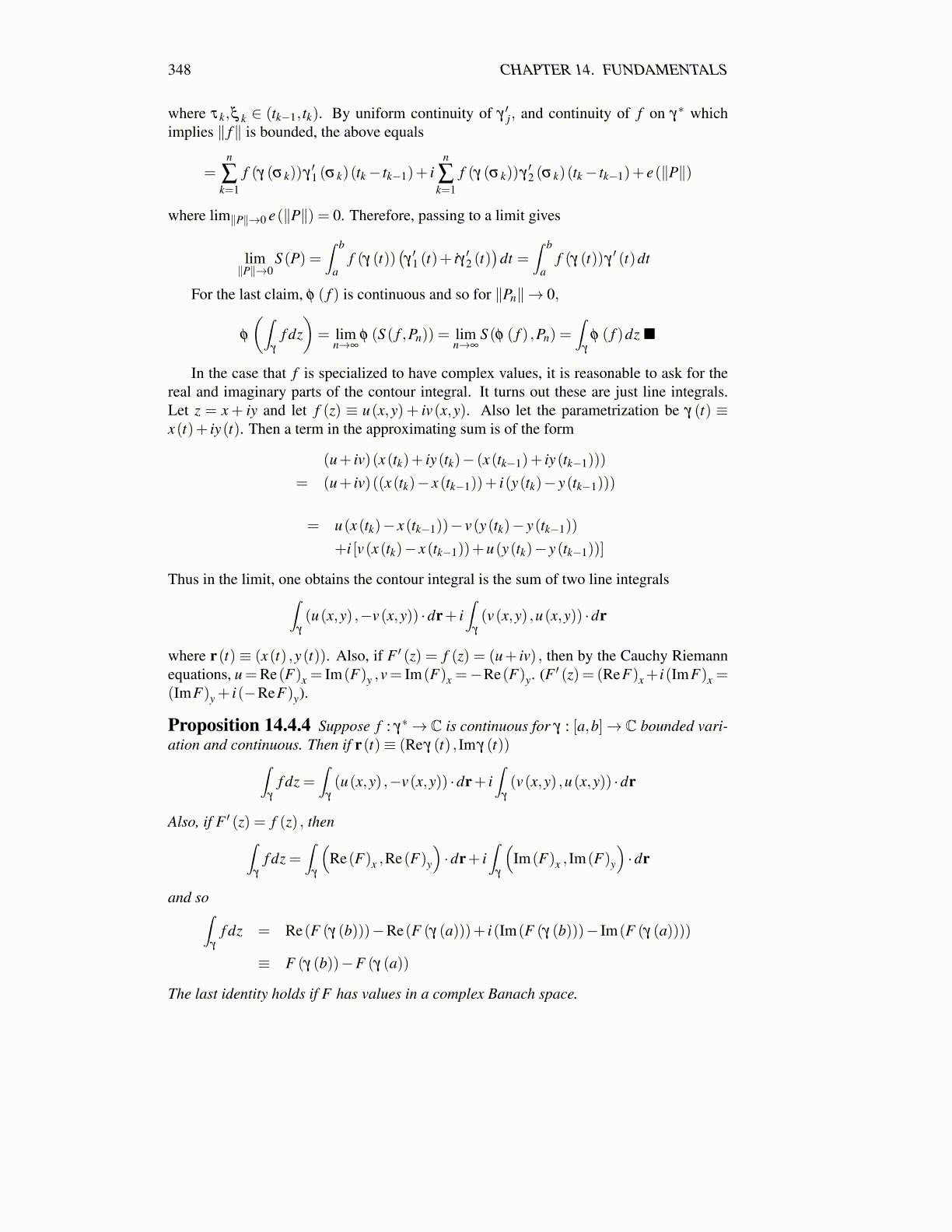
348 CHAPTER 14. FUNDAMENTALS
where τk,ξ k ∈ (tk−1, tk). By uniform continuity of γ ′j, and continuity of f on γ∗ whichimplies ∥ f∥ is bounded, the above equals
=n
∑k=1
f (γ (σ k))γ′1 (σ k)(tk− tk−1)+ i
n
∑k=1
f (γ (σ k))γ′2 (σ k)(tk− tk−1)+ e(∥P∥)
where lim∥P∥→0 e(∥P∥) = 0. Therefore, passing to a limit gives
lim∥P∥→0
S (P) =∫ b
af (γ (t))
(γ′1 (t)+ iγ ′2 (t)
)dt =
∫ b
af (γ (t))γ
′ (t)dt
For the last claim, φ ( f ) is continuous and so for ∥Pn∥→ 0,
φ
(∫γ
f dz)= lim
n→∞φ (S ( f ,Pn)) = lim
n→∞S (φ ( f ) ,Pn) =
∫γ
φ ( f )dz ■
In the case that f is specialized to have complex values, it is reasonable to ask for thereal and imaginary parts of the contour integral. It turns out these are just line integrals.Let z = x+ iy and let f (z) ≡ u(x,y) + iv(x,y). Also let the parametrization be γ (t) ≡x(t)+ iy(t). Then a term in the approximating sum is of the form
(u+ iv)(x(tk)+ iy(tk)− (x(tk−1)+ iy(tk−1)))
= (u+ iv)((x(tk)− x(tk−1))+ i(y(tk)− y(tk−1)))
= u(x(tk)− x(tk−1))− v(y(tk)− y(tk−1))
+i [v(x(tk)− x(tk−1))+u(y(tk)− y(tk−1))]
Thus in the limit, one obtains the contour integral is the sum of two line integrals∫γ
(u(x,y) ,−v(x,y)) ·dr+ i∫
γ
(v(x,y) ,u(x,y)) ·dr
where r(t) ≡ (x(t) ,y(t)). Also, if F ′ (z) = f (z) = (u+ iv) , then by the Cauchy Riemannequations, u=Re(F)x = Im(F)y ,v= Im(F)x =−Re(F)y. (F ′ (z) = (ReF)x+ i(ImF)x =(ImF)y + i(−ReF)y).
Proposition 14.4.4 Suppose f : γ∗→ C is continuous for γ : [a,b]→ C bounded vari-ation and continuous. Then if r(t)≡ (Reγ (t) , Imγ (t))∫
γ
f dz =∫
γ
(u(x,y) ,−v(x,y)) ·dr+ i∫
γ
(v(x,y) ,u(x,y)) ·dr
Also, if F ′ (z) = f (z) , then∫γ
f dz =∫
γ
(Re(F)x ,Re(F)y
)·dr+ i
∫γ
(Im(F)x , Im(F)y
)·dr
and so∫γ
f dz = Re(F (γ (b)))−Re(F (γ (a)))+ i(Im(F (γ (b)))− Im(F (γ (a))))
≡ F (γ (b))−F (γ (a))
The last identity holds if F has values in a complex Banach space.